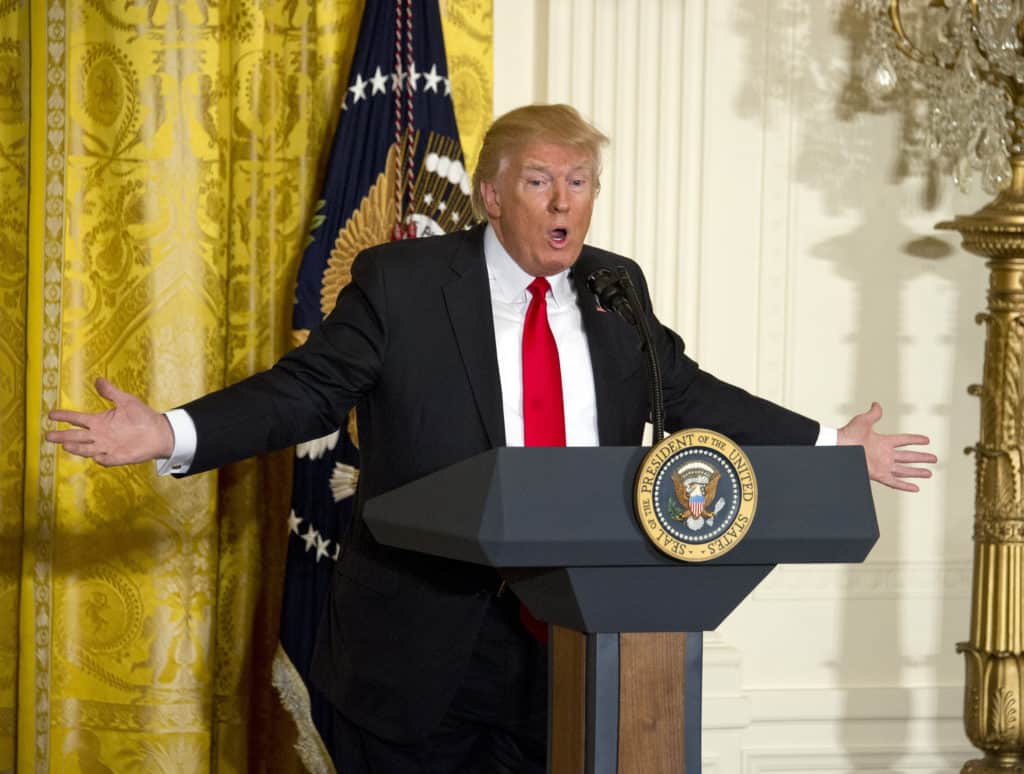Watch What Trump Does, Not What He Says. He May Not Actually End DACA
Ryan Grim, The Intercept, September 5, 2017

Credit Image: © Ron Sachs/CNP via ZUMA Wire
{snip}
“The program known as DACA, that was effectuated under the Obama administration, is being rescinded,” Attorney General Jeff Sessions told reporters, ending the program but implementing a six-month delay before protections are taken away.
{snip}
But people close to Trump say he genuinely does not want to end the program. They said Trump is loath to punish someone who was brought to the U.S. as a young child with no say in the matter. That doesn’t mean, however, that Trump’s personal feelings will save the program.
{snip}
One major hint that Trump may not follow through comes in the form the announcement’s delivery vehicle. On Monday, the administration said Sessions will make the announcement at 11 a.m. Tuesday morning. When have you ever known Trump to shy away from the cameras?
For signs of whether Trump actually intends to deport nearly a million recipients, pay far more attention to the six-month delay than the report that he has “decided to end” the program. During those six months, he’ll ask Congress to deal with the issue. House Speaker Paul Ryan, R-Wisc., has made the politics easy for Trump, having already come out against ending the program.
Either Ryan and Senate Majority Leader Mitch McConnell, R-Ky., fail to act — giving Trump an opening to quietly extend the program again while blaming a do-nothing Congress — or Congress will pass something, and the program gets a blessing from the legislature. In both cases, DACA recipients could retain their protections.
And in the meantime, the Department of Homeland Security aid that it is still accepting applications for two-year renewals of work permits, meaning that the six-month extension could be much longer for some in the program — which gets Dreamers close to 2021, when there could be a new occupant of the Oval Office.
{snip}
The Obama administration launched DACA in August 2012, giving certain unauthorized immigrants brought to the U.S. as children — a group sometimes called “Dreamers” in reference to the failed DREAM Act — relief from deportation for two years, along with eligibility for work permits. Enrollment to the program can be renewed after two years, allowing DACA recipients to stay put for longer periods.
The administrative program came only after the Democratic-controlled Congress failed to pass the original legislation. The Pew Research Center estimated in 2014 that 1.1 million immigrants without proper legal documents qualified for the program. According to the most recent data from U.S. Citizenship and Immigration Services, there are about 790,000 DACA beneficiaries.
{snip}
The deportation amnesty program has faced a series of legal challenges, most notably after the Obama administration’s November 2014 attempt to expand DACA and create a similar program for parents of citizens called Deferred Action for Parents of Americans. Texas and 25 other states with Republican governors filed a lawsuit asking a federal court to enjoin the implementation of DAPA and expanded DACA, arguing that the president had abused his powers by circumventing Congress.
A federal judge in the Southern District of Texas granted the injunction in early 2015, and a divided Supreme Court left the injunction in place in June 2016 without setting any precedent.
In June of this year, Texas Attorney General Ken Paxton, nine other state attorneys general, and the governor of Idaho threatened to sue the Trump administration to stop DACA unless the government voluntarily phased out the amnesty program. They promised to drop the pending Texas lawsuit against DAPA and the expanded DACA program if Trump agreed to end DACA by Tuesday, September 5. Otherwise, they threatened to expand the lawsuit to include the entire DACA program.
There is reason to believe that the lawsuit would prevail, and that reason is named Neil Gorsuch, the newest Supreme Court justice. The court deadlocked 4-4 on the previous case, during a period before the late Justice Antonin Scalia had been replaced.
{snip}
So the Trump administration’s Tuesday announcement accomplished several things at once. It satisfied the states’ attorneys general, who will now pull back on their lawsuit threat. And it satisfied the element of Trump’s base eager for an ultra-hard line on immigration. The protests against the program’s cancellation that have already begun will deepen the feeling among that portion of Trump’s base that he is truly fighting for them.
{snip}
The likelihood of Trump reversing himself and extending the program does not suggest that DACA recipients don’t face real risks.
{snip}
Many of those recipients are already facing crises, as undocumented parents and other family members who were not eligible for the program have become targets of Trump’s ramped-up interior deportations.
But the fight is not over.
{snip}
Update: September 6, 2017
Trump has now publicly suggested he will indeed reverse himself, tweeting: “Congress now has 6 months to legalize DACA (something the Obama Administration was unable to do). If they can’t, I will revisit this issue!”















